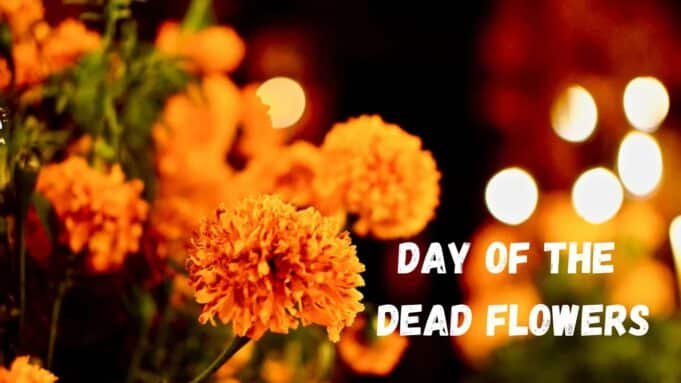Every year, from October 31 to November 2, Mexico bursts into color and fragrance as families gather to celebrate Día de los Muertos, or Day of the Dead. Far from being a somber event, it is a vibrant celebration of life, memory, and love, a time to honor those who have passed while embracing the continuity of existence. At the heart of this beautiful tradition are flowers bright, fragrant, and deeply symbolic.
During Día de los Muertos, flowers are not mere decorations. They are offerings, pathways, and symbols of affection that bridge the worlds of the living and the dead. Each bloom carries meaning, representing remembrance, purity, and the eternal connection between generations.
The Cultural and Spiritual Importance of Flowers
In Mexican tradition, flowers are believed to possess a spiritual energy capable of guiding souls. Their vibrant colors represent the vitality of life, while their fleeting nature reminds us of life’s transience. According to belief, when the spirits of loved ones return during Día de los Muertos, the fragrance and color of flowers help guide them back home.
Altars, or ofrendas, are adorned with layers of petals, candles, and photographs, transforming homes and cemeteries into sacred spaces of remembrance. Every petal, scent, and hue tells a story of devotion, continuity, and joy in celebrating the lives of those who came before us.
Why Are Marigolds Used on the Day of the Dead?
Marigolds, known in Mexico as cempasúchil, are the most iconic flowers used during Día de los Muertos celebrations. Their vibrant orange and yellow hues represent the sun, warmth, and the light of life, guiding spirits of the deceased back to the world of the living. According to ancient Aztec beliefs, the marigold was sacred to Mictecacihuatl, the goddess of death, who governed the afterlife.
During Day of the Dead festivities, marigold petals are used to create pathways of light from doorsteps to altars (ofrendas). It’s believed that the color and fragrance of the flowers help souls find their way home. Beyond their beauty, marigolds symbolize the cyclical nature of life and death, bright and short-lived, just like human existence. Their presence reminds celebrants that love never dies; it simply changes form.
Related: Crowley Lake Columns
Marigolds: The Flower of the Dead
No flower embodies the spirit of Día de los Muertos more than the marigold, or cempasúchil (pronounced sem-pa-soo-cheel). Known as the “flower of the dead,” it is believed that its golden-orange hue reflects the sun’s power, symbolizing life, warmth, and hope.
The use of marigolds dates back to Aztec civilization, where the flower was associated with the goddess Mictecacihuatl, the Lady of the Dead. The Aztecs believed that marigolds had magical powers that could connect the living and the dead. Today, their petals are often scattered on the ground to form paths of light leading from doorways to altars, guiding spirits home through their radiant color and scent.
Cempasúchil flowers are so central to the celebration that entire fields in central and southern Mexico are cultivated specifically for Día de los Muertos. The brilliant orange hue of these blooms has become a visual signature of the festival, a reminder that even in death, there is beauty and brightness.
Other Flowers Used on the Day of the Dead
Beyond the iconic marigold, several other flowers play meaningful roles during the Day of the Dead, each adding color, texture, and symbolic depth to the altars and graves honoring loved ones.
Chrysanthemums
In Mexico, chrysanthemums symbolize death, respect, and mourning. Despite their solemn meaning, they are a common sight on graves and altars, representing the dignity of remembrance. Their full, rounded blooms are often white or yellow, colors associated with peace and light. Chrysanthemums add a graceful touch to the ofrendas, balancing the fiery vibrance of marigolds with calm reverence.
Baby’s Breath (Nube)
The delicate white blossoms of baby’s breath, known locally as nube (meaning “cloud”), symbolize purity, innocence, and eternal love. Often used as a filler in floral arrangements, baby’s breath softens the visual intensity of marigolds and cockscombs, creating a sense of harmony. It is especially common in altars dedicated to children, whose spirits are honored on November 1, known as Día de los Angelitos (“Day of the Little Angels”).
Cockscomb (Terciopelo Rojo)
The cockscomb flower, or terciopelo rojo (“red velvet”), is easily recognizable by its rich, velvety texture and bold crimson hue. It symbolizes the blood of life and sacrifice, serving as a reminder of the passion and vitality that persist beyond death. The flower’s intricate folds resemble a brain, which some interpret as a representation of thought and memory — fitting symbols for a festival dedicated to remembrance.
Gladiolus
The tall, elegant gladiolus represents strength, integrity, and remembrance. Its name comes from the Latin word gladius, meaning “sword,” symbolizing honor and resilience. These flowers are often arranged in vases or wreaths on graves, standing tall as a tribute to loved ones who lived with courage. Gladioli bring vertical beauty and grace to Day of the Dead displays, echoing the idea of spiritual ascension.
Read More: Delta Lake Hike
How Flowers Are Used in Day of the Dead Altars (Ofrendas)
An essential element of Día de los Muertos is the ofrenda, an altar built to welcome the spirits of departed loved ones. Flowers play a central role in these sacred displays. Marigold petals are often arranged in intricate patterns or spread in trails from the entrance of the home to the altar itself, guiding spirits to the offerings prepared for them.
Ofrendas are typically filled with photographs, candles, food, water, sugar skulls, and religious icons. The flowers not only add color and fragrance but also symbolize the ephemeral nature of life. As the blooms wilt over time, they mirror the human journey, beautiful yet fleeting, a reminder that love transcends physical boundaries.
What Do the Colors of the Flowers Represent?
Every color used in Día de los Muertos decorations carries its own meaning. Orange and yellow, the colors of marigolds, represent the sun and the hope of reunion between the living and the dead. Red, often seen in cockscombs and gladiolus, symbolizes blood, life, and remembrance, paying tribute to the sacrifices of those who have passed.
White flowers, such as baby’s breath and chrysanthemums, embody purity and innocence, especially when placed on altars for children during Día de los Angelitos. Purple is associated with mourning and spirituality, reflecting the Catholic influence on the tradition. These colors, when combined, create a vivid expression of both joy and reverence, a visual message that life and death coexist beautifully, each giving meaning to the other.
Read Also: Tourists Disregarding Warning Signs Crater Lake
The Art and Aesthetics of Flower Arrangements
Floral artistry is a key part of Day of the Dead traditions. Families and artisans create elaborate arrangements of arches of marigolds, garlands, wreaths, and crosses to decorate altars and cemeteries. These designs are rich in symbolism: arches represent the passage between life and death, while circular wreaths signify the eternal cycle of existence.
In some regions, such as Oaxaca and Michoacán, people construct flower tunnels and entrances made entirely of marigolds and cockscombs. The combination of bright oranges, deep reds, and soft whites creates a powerful visual message, one that celebrates the coexistence of life, death, and rebirth.
Modern-Day Celebrations and Sustainable Practices
In modern Mexico, the preparation for Día de los Muertos begins weeks in advance. Flower markets in cities like Mexico City, Puebla, and Patzcuaro overflow with marigolds and other seasonal blooms. Families purchase them by the armful, filling streets and homes with the scent of remembrance.
However, the increasing demand has raised concerns about sustainability. Some communities are now turning toward organic flower cultivation and eco-friendly practices to preserve local ecosystems. Urban florists and environmental groups promote reusing petals for composting and using locally grown varieties instead of imported flowers. These changes show how tradition continues to evolve, honoring both ancestors and the environment.
Flowers Beyond Borders: Global Influence
What was once a local Mexican tradition has now blossomed across the world. From Los Angeles to London, Día de los Muertos celebrations feature marigolds as a central symbol of life and death. The flower’s golden hue has become an international emblem of remembrance and resilience, appearing in art exhibits, fashion designs, and even Disney’s Coco.
Beyond their aesthetic appeal, these flowers carry deep meaning, reminding people everywhere of the importance of remembering loved ones with joy rather than sorrow. As Día de los Muertos spreads globally, so does the message of love that its flowers embody.
What Is the Spiritual Meaning of Flowers During Día de los Muertos?
Flowers are believed to serve as a bridge between the physical and spiritual worlds. Their fragrance attracts souls, their colors symbolize vitality, and their fragility mirrors the impermanence of life. In essence, flowers act as messengers, communicating love, remembrance, and celebration to those who have departed.
When families arrange flowers on altars or graves, they are not merely decorating; they are inviting the spirits home. The blooms remind the living that death is not something to fear but to honor as a continuation of life’s journey. This profound use of flowers reflects the Mexican philosophy of embracing death as part of existence, a belief that transforms grief into gratitude.
Are All the Flowers Used for Day of the Dead Native to Mexico?
Not all the flowers used today are originally native to Mexico, though many hold deep roots in the country’s traditions. The marigold (Tagetes erecta), however, is indigenous to Mexico and Central America, and has been cultivated for over 2,000 years. Ancient civilizations like the Aztecs and Mayans used it in ceremonies and offerings to honor their gods and ancestors.
Other flowers, such as chrysanthemums and baby’s breath, were introduced from Europe but have since become integral parts of Day of the Dead observances. Their symbolism blends seamlessly with indigenous beliefs, showing how the festival represents a fusion of pre-Hispanic and Catholic traditions. This cultural blend makes the floral displays of Día de los Muertos a stunning reflection of Mexico’s evolving spiritual identity.
Also Read: Alpine Lake Idaho
How Are Flowers Arranged on Day of the Dead Altars?
Flower arrangements are one of the most visually striking parts of any ofrenda (altar). Traditionally, families create arches of marigolds representing the passage between life and death. Trails of petals are scattered from the home’s entrance to the altar, guiding spirits to their offerings. The altar itself is often layered: each level representing the heavens, earth, and underworld.
Flowers are strategically placed among candles, photos, food, and keepsakes of the departed. The bright colors and natural fragrance make the altar a welcoming space for visiting souls. In cemeteries, families also decorate tombs with flower wreaths and garlands, spending the night celebrating, singing, and sharing food, turning remembrance into a living act of love. The flowers’ presence transforms grief into beauty, emphasizing that death is not an end, but a return.
How Has the Use of Flowers in Día de los Muertos Changed Over Time?
While the symbolic meanings of flowers remain strong, modern practices have evolved. In the past, families grew their own cempasúchil in small gardens or gathered wildflowers for their altars. Today, large flower markets like Jamaica Market in Mexico City and Tenancingo bustle with activity weeks before the celebration, selling millions of blooms.
Recently, awareness of environmental impact has led to a rise in sustainable flower farming and organic cultivation. Many florists now encourage the reuse of petals as compost or biodegradable decorations. Urban and international celebrations have also inspired creative arrangements, merging traditional Mexican styles with global floral design trends. Despite these changes, the essence remains the same; flowers continue to be a symbol of love, remembrance, and spiritual connection.
Conclusion
The flowers of Día de los Muertos are far more than mere decoration; they are living symbols of love, memory, and renewal. Each petal reflects the belief that death is not an end, but a continuation of life’s journey. From the golden marigolds guiding spirits home to the gentle baby’s breath honoring innocence, every bloom tells a story of connection between worlds.
In celebrating the Day of the Dead, Mexicans remind us that remembrance is an act of love, and through the beauty of flowers, the spirits of the departed never truly fade. They bloom, again and again, in the hearts of those who remember them.















